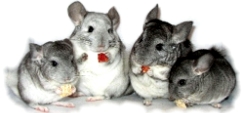The only way to know for sure is a dental exam where the veterinarian looks directly inside of the mouth with a speculum. Another way that is also very effective is an x-ray and can sometimes see things that you can't see with a regular exam. These procedures require anesthesia and should only be performed if there is a good reason to think there are tooth problems.
The best thing to do is prevent tooth problems by providing a high quality pelleted diet, and constant access to loose hay and chew toys.
If tooth problems occur it is usually from overgrowth of the teeth. A rodent's teeth grows constantly. Each tooth must stay trimmed by grinding against the food and the opposite tooth. If the surface of the teeth don't line up (dental malocclusion) the grinding pattern becomes uneven and parts of the tooth overgrow like little spikes. These are sometimes called tooth spurs. These spikes deflect outward the cheek wall or inward into the tongue and start doing some damage. The roots also overgrow and they can damage the bones of the skull or interfere with the tear ducts or eyes. Needless to say untreated tooth problems are a death sentence for chinchillas.
The best way to screen for problems is to monitor your chin's weight week after week. Also to monitor your chin's food intake by comparing its weight to an estimate of how much food is eaten and also compare its daily fecal output. If problems arise you will see a decrease in appetite and weight loss. It may be slow and steady, but sometimes it can be sudden. This is because the teeth slowly overgrow into the inside of the mouth and cause cuts and open sores. This usually develops an infection in the mouth (abscess) that causes it to stop eating from the pain.
A rule of thumb is if you see a 20% change in weight in the long run (or if over a few weeks 15% is sufficient) then you should see a vet. Or if you suspect your pet has stopped eating/pooping that is an emergency.
Tooth problems, just like in people, can have different causes. The prognosis is related to the cause. If you drop your chinchilla and it breaks a front tooth that is curable depending on the severity. If your chinchilla has a genetic skull deformity that causes malocclusion of the teeth you have the option of regular tooth filings. Sometimes it is so severe the best thing to do is euthanize.
In my case I had a chin euthanized because I didn't think it was worth the expense of trying something that I wasn't sure would work. If you have a chin with a tooth problem that you are willing to manage long term I strongly recommend having an x-ray done first.
If it's caused by tooth decay you may be able to have the tooth extracted (which would have to include the opposite tooth) but the risk of alignment problems in the skull may increase. Another thing that sometimes happens later (10+ years) in a chin's life is "lazy eating" where they are not grinding down enough. This can be managed by filings.
If it is caused by poor diet you may also have a skull deformity if there was calcium deficiency. The chances of recovery are iffy but there is still hope if you have the teeth floated.

 Author
Topic: How will I know if chin has dental issues? (Read 1204 times)
Author
Topic: How will I know if chin has dental issues? (Read 1204 times)




